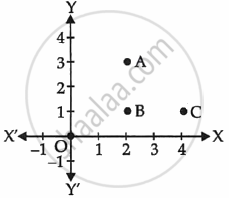Advertisements
Advertisements
प्रश्न
Determine whether the point is collinear.
R(0, 3), D(2, 1), S(3, –1)
उत्तर
R(0, 3), D(2, 1), S(3, –1)
RD = \[\sqrt{\left( 2 - 0 \right)^2 + \left( 1 - 3 \right)^2}\]
= `sqrt((2)^2 + (- 2)^2)`
= `sqrt(4 + 4)`
= `sqrt8`
= `sqrt(4 xx 2)`
= `2sqrt2`
DS = `sqrt((3 - 2)^2 + ((-1) - 1)^2)`
= `sqrt((1)^2 + (-2)^2)`
= `sqrt(1 + 4)`
= `sqrt5`
RS = `sqrt((3 - 0)^2 + ((-1) - 3)^2)`
= `sqrt((3)^2 + (-4)^2)`
\[ = \sqrt{9 + 16}\]
\[ = \sqrt{25}\]
\[ = 5\]
Sum of two sides is not equal to the third side.
Hence, the given points are not collinear.
APPEARS IN
संबंधित प्रश्न
If the point P(x, y) is equidistant from the points A(a + b, b – a) and B(a – b, a + b). Prove that bx = ay.
If the point A(0, 2) is equidistant from the points B(3, p) and C(p, 5), find p. Also, find the length of AB.
Find the coordinates of the centre of the circle passing through the points (0, 0), (–2, 1) and (–3, 2). Also, find its radius.
Check whether (5, -2), (6, 4) and (7, -2) are the vertices of an isosceles triangle.
Find the value of a when the distance between the points (3, a) and (4, 1) is `sqrt10`
Show that the points A(1, 2), B(1, 6), C(1 + 2`sqrt3`, 4) are vertices of an equilateral triangle.
Find the relation between a and b if the point P(a ,b) is equidistant from A (6,-1) and B (5 , 8).
Find the point on the x-axis equidistant from the points (5,4) and (-2,3).
The centre of a circle passing through P(8, 5) is (x+l , x-4). Find the coordinates of the centre if the diameter of the circle is 20 units.
A(-2, -3), B(-1, 0) and C(7, -6) are the vertices of a triangle. Find the circumcentre and the circumradius of the triangle.
Prove that the points (6 , -1) , (5 , 8) and (1 , 3) are the vertices of an isosceles triangle.
ABC is an equilateral triangle . If the coordinates of A and B are (1 , 1) and (- 1 , -1) , find the coordinates of C.
Find the distance between the origin and the point:
(-5, -12)
A point A is at a distance of `sqrt(10)` unit from the point (4, 3). Find the co-ordinates of point A, if its ordinate is twice its abscissa.
Prove that the points A (1, -3), B (-3, 0) and C (4, 1) are the vertices of an isosceles right-angled triangle. Find the area of the triangle.
Find distance CD where C(– 3a, a), D(a, – 2a)
Using distance formula decide whether the points (4, 3), (5, 1), and (1, 9) are collinear or not.
The distance between the points A(0, 6) and B(0, -2) is ______.
Name the type of triangle formed by the points A(–5, 6), B(–4, –2) and C(7, 5).
Read the following passage:
|
Alia and Shagun are friends living on the same street in Patel Nagar. Shagun's house is at the intersection of one street with another street on which there is a library. They both study in the same school and that is not far from Shagun's house. Suppose the school is situated at the point O, i.e., the origin, Alia's house is at A. Shagun's house is at B and library is at C. |
Based on the above information, answer the following questions.

- How far is Alia's house from Shagun's house?
- How far is the library from Shagun's house?
- Show that for Shagun, school is farther compared to Alia's house and library.
OR
Show that Alia’s house, shagun’s house and library for an isosceles right triangle.
